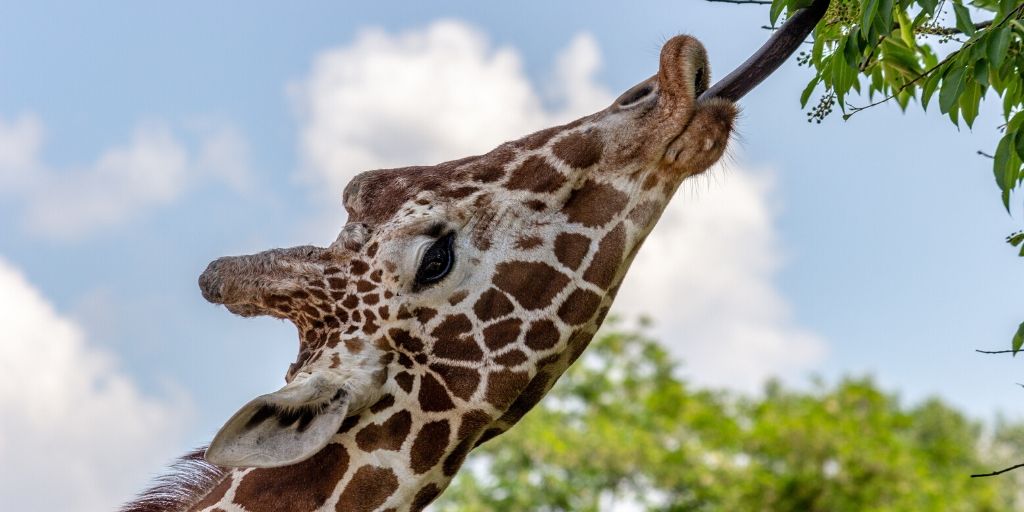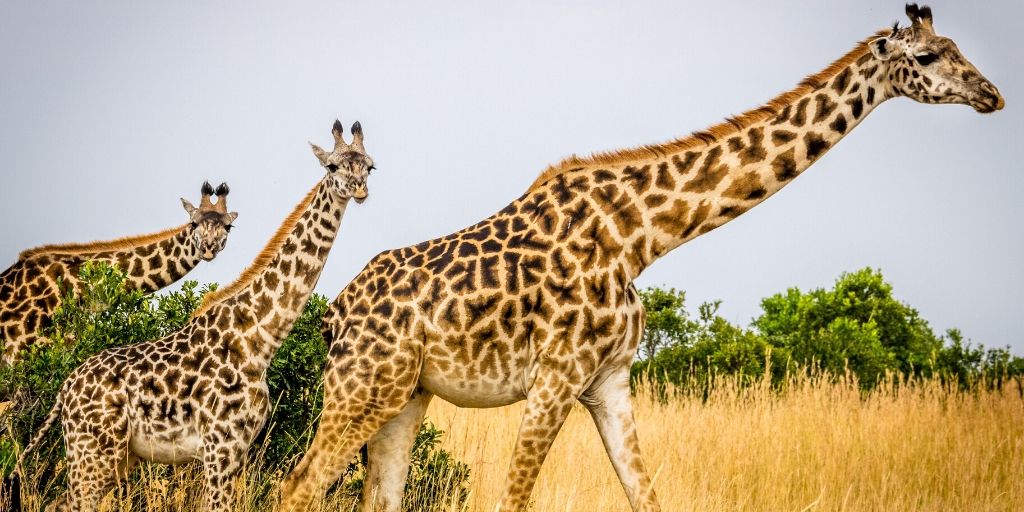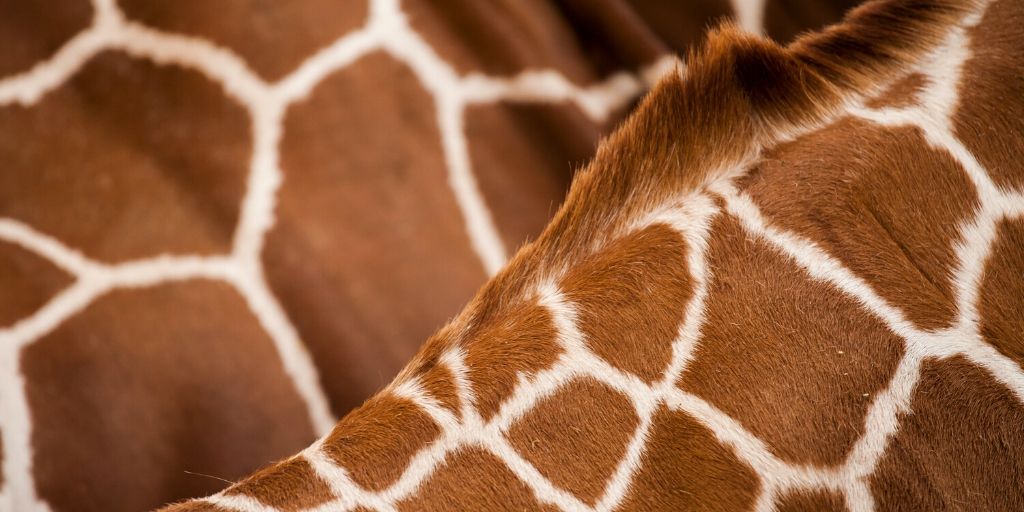Perhaps the ultimate icon of the African savanna, the giraffe is an unmistakable land mammal known for its long neck and spotted coat. Read on for a few interesting facts about this intriguing animal.
Latin name: Giraffa camelopardalis
Group name: Tower
Size: 4.3 meters to 5.7 meters tall
Weight: 1,192 kg for an adult male and 828 kg for an adult female
Skip to: Characteristics, Range & habitat, Diet, Behaviour, Fun facts, Video

Giraffe characteristics
With nine subspecies sharing its distinctive characteristics, the giraffe is the tallest land animal and the largest ruminant on earth. Considering the length of its neck and legs, the giraffe’s body is quite short. The giraffe sees in colour and its eyes are located on either side of its head, giving it a good view of its surroundings and any approaching predators. Moreover, it has a sharp sense of hearing and smell, another defense against predators, while it can close its nostrils during sandstorms and against ants.
Considering its long neck, it’s no wonder the giraffe has an unusually long tongue – about 45 cm to be exact. Giraffes use their tongues to deftly pick leaves from between thorns.
The giraffe’s coat is characterised by dark blotches on lighter hair. With age, male giraffes may become darker, and while calves inherit spot patterns from their mothers, each giraffe has a unique coat pattern that sets it apart.
Underneath their spotted coats, however, the giraffe is actually gray in colour, with a skin that is quite thick and allows it some protection from thorns.


Range & habitat
With a range that extends all over most of Africa, the giraffe is a staple sighting on any African safari. They are, however, most common in southern and eastern Africa, where the savannas and open woodlands offer the perfect habitat. However, the Angolan giraffe, which occurs in Namibia as well, prefers a more desert environment.
Giraffes have home ranges but are not territorial. Home ranges will vary relative to factors such as rainfall and proximity to humans.
Overall though, giraffes prefer to inhabit savannas and woodlands that are open with foliage like the acacia tree, instead of more dense environments like miombo woodlands.
During the wet season, groups of giraffe may be more spread out, enjoying the resplendent food sources around them. But when the dry season arrives, giraffes are found to congregate around the few evergreen bushes and trees in their area.
Giraffes mothers tend to feed where an area is most open, which gives her a better view over the surroundings and any danger close by.
Diet
Giraffes feed mainly on leaves, fruits and flowers of acacia trees, easily reaching up to nibble on the top parts that other herbivores can’t reach. Acacias seem to be one of their favourite sources of food, as well as trees from the Commiphora and Terminalia genera, which provide giraffes with their much-needed source of protein and calcium.
Notwithstanding their long necks, giraffes may also bend down and feed on shrubs and grasses. All in all, they feed and ruminate for most of the day, consuming a total of about 34 kg of foliage every day. However, the giraffe actually needs much less food than other herbivores as the food it does get is much higher in nutrients, while its digestive system is extremely efficient.


Behaviour & lifestyle
When out on safari, keep a lookout for giraffes arranged in groups of calves watched over by one or two mothers. These calving pools are often colloquially referred to as giraffe creches and they allow the mothers to feed elsewhere while a trusted individual keeps a lookout for danger.
For the most part, giraffe herds consist of either related females and their offspring or groups of unrelated adult bachelors. However, the different groups may sometimes come together and gather in larger herds.
Giraffe hierarchies are established by the males through an activity known as “necking” in which two giraffes use their necks as a weapon during fights, swinging and hitting each other. The winning male is dominant and has better access to the fertile females for reproduction. However, when it comes to raising the young, that is solely in the sphere of female giraffes.
Female giraffes give birth to their young standing up. The calf drops to the ground, which severs the umbilical cord. After its mother has groomed and cleaned the newborn, the calf will slowly attempt to stand up, but within a few hours it will be able to run around.
Fun giraffe facts
- Giraffes spend most of their lives standing up, even giving birth standing up. The calves fall up to 2 meters to the floor at birth as their introduction to the world.
- Giraffes don’t need much sleep to function, typically getting less than two hours each day!
- Giraffes can run at speeds of up to 56 kilometers per hour over short distances!
- Like human fingerprints, each giraffe’s spot pattern is completely unique, and no two are the same.
Meet the giraffe
Have you seen a giraffe in the wild? What is your favourite memory of an African safari that involved giraffes? Tell us in the comments below!
References
Dagg, A. I. (1971). “Giraffa camelopardalis” (PDF). Mammalian Species. 5 (5): 1–8. doi:10.2307/3503830. JSTOR 3503830.
Estes, R. (1992). The Behavior Guide to African Mammals: including Hoofed Mammals, Carnivores, Primates. University of California Press. pp. 202–07. ISBN 978-0-520-08085-0.
Fennessy, J. (2004). Ecology of desert-dwelling giraffe Giraffa camelopardalis angolensis in northwestern Namibia (Ph.D. thesis). University of Sydney.
Fennessy, S.; Fennessy, J.; Muller, Z.; Brown, M. & Marais, A. (2018). “Giraffa camelopardalis ssp. rothschildi”. IUCN Red List of Threatened Species. 2018.
Kingdon, J. (1988). East African Mammals: An Atlas of Evolution in Africa, Volume 3, Part B: Large Mammals. University Of Chicago Press. pp. 313–37. ISBN 978-0-226-43722-4.
Kingdon, J. (1997). The Kingdon Field Guide to African Mammals. Academic Press. pp. 339–44. ISBN 978-0-12-408355-4.
Knüsel, Mara; Lee, Derek; König, Barbara; Bond, Monica (March 2019). “Correlates of home range sizes of giraffes, Giraffa camelopardalis“. Animal Behaviour. 149: 143–151. doi:10.1016/j.anbehav.2019.01.017.
Prothero, D. R.; Schoch, R. M. (2003). Horns, Tusks, and Flippers: The Evolution of Hoofed Mammals. Johns Hopkins University Press. pp. 67–72. ISBN 978-0-8018-7135-1.
Simmons, R. E.; Scheepers, L. (1996). “Winning by a Neck: Sexual Selection in the Evolution of Giraffe” (PDF). The American Naturalist. 148 (5): 771–86. doi:10.1086/285955.
Skinner, J. D.; Smithers, R. H. M. (1990). The mammals of the southern African subregion. University of Pretoria. pp. 616–20. ISBN 978-0-521-84418-5.
Swaby, S. (2010). “Giraffe”. In Harris, T. (ed.). Mammal Anatomy: An Illustrated Guide. Marshall Cavendish. pp. 64–84. ISBN 978-0-7614-7882-9.
Williams, E. (2011). Giraffe. Reaktion Books. ISBN 978-1-86189-764-0.
